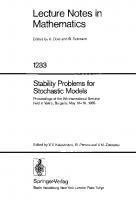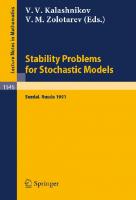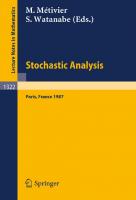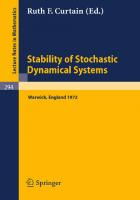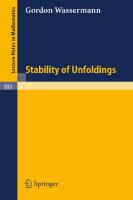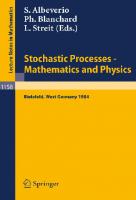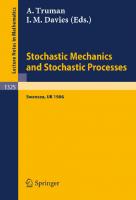Stability Problems for Stochastic Models: Proceedings of the 6th International Seminar Held in Moscow, USSR, April 1982 (Lecture Notes in Mathematics, 982) 3540122788, 9783540122784
English, Russian (translation)
133 61 15MB
English Pages 320 [317] Year 1983
Recommend Papers
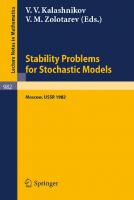
- Author / Uploaded
- V.V. Kalashnikov (editor)
- V.M. Zolotarev (editor)
File loading please wait...
Citation preview
Lecture Notes in Mathematics For information about Vols. 1-758, please contact your book· seller or Springer-Verlag.
Vol. 787: Potential Theory, Copenhagen 1979. Proceedings, 1979. Edited by C. Berg, G. Forst and B. Fuglede. VIII, 319 pages. 1980.
Vol. 759: R. L. Epstein, Degrees of Unsolvability: Structure and Theory. XIV, 216 pages. 1979.
Vol. 788: Topology Sympos1um, Siegen 1979. Proceedings, 1979. Edited by U. Koschorke and W. D. Neumann. VIII, 495 pages. 1980.
Vol. 760: H.·O. Georgii, Canonical Gibbs Measures. VIII, 190 pages. 1979.
Vol. 789: J. E. Humphreys, Arithmetic Groups. VII, 158 pages. 1980.
Vol. 761: K. Johannson, Homotopy Equivalences of 3-Manifolds with Boundaries. 2, 303 pages. 1979. Vol. 762: D. H. Sattinger, Group Theoretic Methods in B1furcation Theory. V, 241 pages. 1979. Vol. 763: Algebraic Topology, Aarhus 1978. Proceedings, 1978. Edited by J. L. Dupont and H. Madsen. VI, 695 pages. 1979. Vol. 764: B. Srinivasan, Representations of Finite Chevalley Groups. XI, 177 pages. 1979. Vol. 765: Pade Approximation and its Applications. Proceedings, 1979. Edited by L. Wuytack. VI, 392 pages. 1979. Vol. 766: T. tom Dieck, Transformation Groups and Representation Theory. VIII, 309 pages. 1979. Vol. 767: M. Namba, Families of Meromorphic Functions on Compact Riemann Surfaces. XII, 284 pages. 1979. Vol. 768: R. S. Doran and J. Wichmann, Approximate Identities and Factorization in Banach Modules. X. 305 pages. 1979. Vol. 769: J. Flum, M. Ziegler, Topological Model Theory. X, 151 pages. 1980. Vol. 770: Seminaire Bourbaki val. 1978/79 Exposes 525-542. IV, 341 pages. 1980. Vol. 771: Approximation Methods for Navier-Stokes Problems. Proceedings, 1979. Edited by R. Rautmann. XVI, 581 pages. 1980.
Vol. 790: W. Dicks, Groups, Trees and Projective Modules. IX, 127 pages. 1980. Vol. 791: K. W. Bauer and S. Ruscheweyh, Differential Operators for Partial Differential Equations and Function Theoretic Applications. V, 258 pages. 1980. Vol. 792: Geometry and Differential Geometry. Proceedings, 1979. Edited by R. Artzy and I. Vaisman. VI, 443 pages. 1980. Vol. 793: J. Renault, A Groupoid Approach to c··Aigebras. Ill, 160 pages. 1980. Vol. 794: Measure Theory, Oberwolfach 1979. Proceedings 1979. Edited by D. Kolzow. XV, 573 pages. 1980. Vol. 795: Seminaire d'Aigebre Paul Dubreil et Marie-Paule Malliavin. Proceedings 1979. Edited by M. P. Malliavin. V, 433 pages. 1980. Vol. 796: C. Constantinescu, Duality in Measure Theory. IV, 197 pages. 1980. Vol. 797: S. Maki, The Determination of Units in Real Cyclic Sextic Fields. Ill, 198 pages. 1980. Vol. 798: Analytic Functions, Kozubnik 1979. Proceedings. Edited by J.t.awrynow1cz. X, 476 pages. 1980. Vol. 799: Functional Differential Equations and Bifurcation. Proceedings 1979. Edited by A. F. lze. XXII, 409 pages. 1980. Vol. 800: M.-F. Vigneras, Arithmetique des Algebres de Ouaternions. VII, 169 pages. 1980.
Vol. 772: J. P. Levine, Algebraic Structure of Knot Modules. XI, 104 pages. 1980.
Vol. 801: K. Floret, Weakly Compact Sets. VII, 123 pages. 1980.
Vol. 773: Numerical Analysis. Proceedings, 1979. Edited by G. A. Watson. X, 184 pages. 1980.
Vol. 802: J. Bair, R. Fourneau, Etude Geometrique des Espaces Vectoriels II. VII, 283 pages. 1980.
Vol. 774: R. Azencott, Y. Guivarc'h, R. F. Gundy, Ecole d'Ete de Probabilites de Saint-Flour Vlll-1978. Edited by P. L. Hennequin. XIII, 334 pages. 1980.
Vol. 803: F.-Y. Maeda, Dirichlet Integrals on Harmonic Spaces. X, 180 pages. 1980.
Vol. 775: Geometric Methods in Mathematical Physics. Proceedings, 1979. Edited by G. Kaiser and J. E. Marsden. VII, 257 pages. 1980.
Vol. 804: M. Matsuda, First Order Algebraic Differential Equations. VII, 111 pages. 1980.
Vol. 776: B. Gross, Arithmetic on Elliptic Curves with Complex Multiplication. V, 95 pages. 1980.
Vol. 805: 0. Kowalski, Generalized Symmetric Spaces. XII, 187 pages. 1980.
Vol. 777: Seminaire sur les Singularites des Surfaces. Proceedings, 1976·1977. Edited by M. Demazure, H. Pinkham and B. Teissier. IX, 339 pages. 1980.
Vol. 806: Burnside Groups. Proceedings, 1977. Edited by J. L. Mennicke. V, 274 pages. 1980.
Vol. 778: SK1 von Schiefkorpern. Proceedings, 1976. Edited by P. Draxl and M. Kneser.ll, 124 pages. 1980. Vol. 779: Euclidean Harmonic Analysis. Proceedings, 1979. Edited by J. J. Benedetto. Ill, 177 pages. 1980. Vol. 780: L. Schwartz, Semi-Martingales sur des Variates, et Martingales Conformes sur des Variates Analytiques Complexes. XV, 132 pages. 1980. Vol. 781: Harmonic Analysis lraklion 1978. Proceedings 1978. Edited by N. Petri dis, S. K. Pichorides and N. Varopoulos. V, 213 pages. 1980. Vol. 782: Bifurcation and Nonlinear Eigenvalue Problems. Proceedings, 1978. Edited by C. Bardos, J. M. Lasry and M. Schatzman. VIII, 296 pages. 1980. Vol. 783: A. Dinghas, Wertverteilung meromorpher Funktionen in ein- und mehrfach zusammenhangenden Gebieten. Edited by R. Nevanlinna and C. Andreian Cazacu. XIII, 145 pages. 1980. Vol. 784: Seminaire de Probabilites XIV. Proceedings, 1978/79. Edited by J. Azema and M. Yor. VIII, 546 pages. 1980. Vol. 785: W. M. Schmidt, Diophantine Approximation. X, 299 pages. 1980. Vol. 786: I. J. Maddox, Infinite Matrices of Operators. V, 122 pages. 1980.
Vol. 807: Fonctions de Plusieurs Variables Complexes IV. Pro· ceedings, 1979. Edited by F. Norguet. IX, 198 pages. 1980. Vol. 808: G. Maury et J. Raynaud, Ordres Maximaux au Sens de K. Asano. VIII, 192 pages. 1980. Vol. 809: I. Gumowski and Ch. Mira, Recurences and Discrete Dynamic Systems. VI, 272 pages. 1980. Vol. 810: Geometrical Approaches to Differential Equations. Proceedings 1979. Edited by R. Martini. VII, 339 pages. 1980. Vol. 811: D. Normann, Recursion on the Countable Functionals. VIII, 191 pages. 1980. Vol. 812: Y. Namikawa, Toroidal Compactification of Siegel Spaces. VIII, 162 pages. 1980. Vol. 813: A. Campillo, Algebroid Curves in Positive Characteristic. V, 168 pages. 1980. Vol. 814: Seminaire de Theorie du Potentiel, Paris, No.5. Proceed· ings. Edited by F. Hirsch et G. Mokobodzki. IV, 239 pages. 1980. Vol. 815: P. J. Slodowy, Simple Smgularities and Simple Algebraic Groups. XI, 175 pages. 1980. Vol. 816: L. Stoica, Local Operators and Markov Processes. VIII, 104 pages. 1980.
continuation on page 301
Lecture Notes in Mathematics Edited by A. Oold and B. Eckmann
982 Stability Problems for Stochastic Models Proceedings of the Held in Moscow, USSR, April 1982
Edited by V. V. Kalashnikov and V. M. Zolotarev
Spri nger-Verlag Berlin Heidelberg New York Tokyo 1983
Editors
V.V. Kalashnikov Institute for Systems Studies Ryleyev st, 29,119034 Moscow, USSR V.M. Zolotarev Steklov Mathematical Institute Academy of Sciences of the USSR Vavilov st. 42, 117333 Moscow, USSR
AMS Subject Classifications (1980): 60 B 10, 60 B 99, 60 E10, 60 E 99, 60F05, 60K25, 60K99, 62El0, 62FlO, 62F35, 62H12, 62P99 ISBN 3-540-12278-8 Springer-Verlag Berlin Heidelberg New York Tokyo ISBN 0-387-12278-8 Springer-Verlag New York Heidelberg Berlin Tokyo
This work is subject to copyright. All rights are reserved, whether the whole or part of the material is concerned, specifically those of translation, reprinting, re-use of illustrations, broadcasting, reproduction by photocopying machine or similar means, and storage in data banks. Under § 54 of the German Copyright Law where copies are made for other than private use, a fee is payable to "Verwertungsgesellschaft Wort", Munich.
© by Springer-Verlag Berlin Heidelberg 1983 Printed in Germany Printing and binding: Beltz Offsetdruck, Hemsbach/Bergstr. 2146/3140-543210
Con t e n t s Zolotarev V.M. Foreword,
VII
Anichkin S.A. Hypererlang approximation of probability distributions on (Q, 00) and its application • . . . . . . . . . . . . . . . . . . Azlarov T.A., Volodin N.A. On the discrete analog of Marshall-Olkin 's distribution
17
Gnedenko B.V. On some stability theorems • . . . . . . . . . . . . . . . . . . . . . . . . . 24 Hohlov Yu.S. On stability estimation of certain characterization of the exponential distribution
32
Ivnitsky V.A. Accuracy estimation of the results of complex systems simulation with vector output and several types of randomnesses..................................... 38 Kalashnikov V.V. A complete metric in the function space 1J (OJ 00) and its application.................................... 60 Klebanov L.B., Manija G.M., Melamed J.A. On the estimation of location and scale parameters of stable laws
77
Klebanov L.B., Melamed J.A. Discretization in the problems of stability of characterization of the exponential distribution • . . . . . . . . . . . . . . . . . . . . . . . . . . . . . . . . . . . . . . . . . . . . . . . . . . . . . 110 M.V., L.B. Some questions of stability theory of the stochastic economical models . . . . . . . . • . . . . . . . . . . . . . . . 123 Obretenov A., Rachev S. Characterizations of the bivariate exponential distribution and Marshall-Olkin distribution and stability,. . . . . . . . . . . . . . . . . . . . . . . • . . . . . . . . . . . . . . . . . . . . . . . . 136 Ostrovskii I.V. On the growth of entire characteristic functions .'
151
Panaretos J. An elementary characterization of the multinomial and the multivariate hypergeometric distributions ,
156
Petrova L.L. On the stability of characterizations of the unit distribution
165
Rachev S.T. Minimal metrics in the real random variables space
172
Rydel A. On poisson output of queueing systems
191
Senatov V.V. On a relation between Levy-Prohorov metrics and ideal metrics • . . . . . . . . . . . . . . . . . . . . . . . . . . . . . . . . . . . . . . . . 213 Shimizu R. On the stability of lack of memory characterization of the exponential
217
IV
v
Siganov I.S. Several remarks on applications of one approach to studies of characterization problems of Polya I s theorem type . . . . . . . . . . . . . . . . . . . . . • . . . . . . . . . . . . . . . . . . . . . 22 7 Szulga A. On the metrics of the type
238
Wolinska A. On a problem of DUguJ
24 4
Yanushkevichius R.V., Yanushkevichiene O.L. Limit theorems in the problems of stability
2 54
Zieli6ski R. Robust statistical procedures: a general approach. • • • . . . . . . . . . . • • . . . . . . . . . . . . . . . . . . . . . . . . . . . . . . . . . . . . . 2 83
Reports not included in this volume Anichkin S.A. (Moscow, USSR). On coupling of renewal processes and its application: a review. Bednarski T. (Wroclaw, Poland). On minimax testing between Prohorov neighbourboods of probability measures. Bentkus B., Rachkauskas A. central limit theorem in
(Vilnius, USSR). Rate of convergence in the spaces in different metrics.
v
Cerkasov I.D. (Saratov, USSR). On optimal deviation of the diffusion process from the stable deterministic chasing.
"C istjakov
G.P. (Harkov, USSR). On stability of decomposition of infinitely-divisible distributions.
Dimitrov B. (Sofia, Bulgaria), Klebanov L.B. (Leningrad, USSR), Rachev S. (Sofia, Bulgaria). On stability of some characterization of the exponential distribution. A.A. ic models.
(Novokuznetsk, USSR). The problem of robustness of
v " Ginzburg B.l., Sarsanova G.P. of characteristic functions. HUu Nhu,
Ngok
(Harkov, USSR). Analytical peculiarities (Hanoi, Vietnam)
e
-sufficient statistics.
Illin V.V. (Leningrad, USSR). On the estimate of the stability of decomposition of the normal law on the components. Klebanov L.B. (Leningrad, USSR), Mkrtcjan S.T. (Erevan, USSR). Some problems in stability of characterizations of distributions. Landsman Z.M. USSR) On some classes of the families of distributions, characterising by the minimal Fisher information property. Lisek B. (Berlin, DDR). Some new results on the existence and stability of the solutions of the equalities of the type- Y = S' (Yo, X,j ) nt 1
v
Malosevskii S.G. (Leningrad, USSR). The estimate of stability of the characterizations of distributions with the help of some first moments.
"
Muhin A.B. (Taskent, USSR). On the stability of characterization of the lattice distributions and its application. Rachev S. (Sofia, Bulgaria). On metrization of weak convergence together with the convergence of the moments. Seidl L. Hungary). On the continuity of the certain class of the networks of gueues.
"
Seryh A.P., Tarasenko F.P., Sulenin V.P. (Tomsk, USSR). On the asymptotic properties of the family of the stable R - estimates of the 01. location parameter.
VI
Skrjabin D.O. (Jakutsk, USSR). On the stability in the problem of reconstruction of the distribution by the distributions of some statistics. v
Surygin A.M. (Moscow, USSR). Robustness and optimization of the asimptotic stability of the estimates of parameters. v
Tsitsiashvili G.S. (Vladivostok, USSR). Probability metrics and orderings invariant to transformations giving by the signs of derivatives. Tsitsiashvili G.S. On the problem of the statistic of mixing flow.
fl
V.E. USSR). Many-dimensional -stable distributions and realizations of generalised convolutions. Vyndev D., Ignatov Z., Rachev S. (Sofia, Bulgaria). On the metrics invariant to monotone transformations. Weron A.
(Wroclaw, Poland). On stable measures in Banach space.
Yanushkevichiene O.L. (Vilnius, USSR). On the stability of characterization by the lack of memory properties in two points. Ja. (Praga, Czechoslovakia). Asymptotic behaviour of -estimators of location in nonregular case.
M
Zinger A.A. (Leningrad, USSR). On the generalization of the characterization theorem due to Linnik-Anosov and its stability. Zinger A.A. (Leningrad, USSR), Yanushkevichius R.V. (Vilnius, USSR) On the stability of characterization theorem due to Yu.V.Linnik. Zolotarev V.M. (Moscow, USSR). On the method of metrical distances in stability problems.
For e w 0 r d The place in
__frorn
of Stochastic f)tCi1:)i}i!=-X took Al?ril 1982. The previous seminars were
organized as follows: in Leningrad and Vilnius (1974), in Moscow (1977), in Palanga, Lithuanian SSR (1979), and in paneveiis, Lithuanian SSR (1980). The
material
of these seminars
was
published in four
special proceedings (1) - [4J . Short information about the 4th and 5th seminars and summaries of some of the papers were published in
[5J
and [6] • The 6 th seminar was organized by the Steklov Mathematical Institute of the Academy of Sciences of USSR (MIAN), the International Research Institute of Control Problems (MNIIPU), which assumed the greatest part of the care of organizing the seminar, and the Institute for Systems studies (VNIISI). The organizing committee consisted of Academician Prof.S.V.Emeljanov - Chairman (MNIIPU), Prof. V.M.Zolotarev - Vice-chairman (MIAN), Prof. V.V.Kalashnikov (VNIISI) and Dr. V.I.Lutkov - Secretary (MNIIPU). There were 47 reports submitted by representatives of well known mathematical centres of seven countries. Those reports not included in this vOlume are listed by title. The present proceedings include papers based on the reports submitted at the seminar, as well as a paper by the Japanese mathematician R. Shimizu (presented at the Soviet-Japanese symposium on Probability theory, held at the end of August 1982 in Tbilisi), and a paper by the Greek mathematician J. Panaretos (delivered at the International Conference on Probability theory, held in Vilnius in June 1981). A characteristic fe2ture of all six seminars on Problems of Stochastic models stability was the great variety of topics in the rapers delivered. Though most of the reports have always been devoted to the main topic of the seminar, the papers presented here featured such problems as characterization of distributions, investigations of probability metrics, characteristic functions, etc. The point is that the respective interests within probability theory and its application of most of the participants are often qUite far apart from each other. The fact that the seminar managed, during its existence, not only to retain, but also increase the number of "permanent" participants can be explained first and foremost by a tradition, created at the seminar, according
VIII
to which every participant could pose any problem in which he had taken a lively interest. The discussion of the contributions to our seminars was performed from the viewpoint of their general tendency, i.e. from one of the general conceptions of stability. Of course the participants interest in the stability problems isn't of itself sufficient for such a practice to be a success. It is necessary to have also some general conceptual and methodological approach to the stabi lity phenomenon. During the existence of the seminar such a general approach was outlined and here we give a brief review of it. The notion of stochastic model stability can be explained within
f J
the framework of the following scheme. Let !Je = {X} and dfj Y be sets of random variables defined on a probability space and taking values from the corresponding measurable spaces
(V. !J.ry )
. Suppose that some mapping
is given and the sets
}/;
X
tions imposed on the random images in
djj
and
IF'
(
1J,
of the set
1b g "!:!
5t
and into
(see Fig.1).
$r ={X}
Y={Y}
X6 . _ '
::>'7.
3e' Fig. 1 The problems connected with the triplet (JfJJ§,f) are divided into direct problems in which one is interested in the properties of the values from the set
(! = ..5'5 (I
f ::It
,
and the inverse ones
in which the object of the investigation is the set (here denotes the preimage of the set
IF
'!J
describe the condi tl't' and their variables mapping from
IX
Note that two important particular cases of this model corres-
.:II: = !1C
pond to large classes of problems when
or
CY.
=
The concept of stability of direct and inverse problems is rela ted
to
certain
the
and
probability metrics
11
t'
V JlI £: 1£ .
and
and to a certain set
defined on
Under the notion of the probability metric in
06.(-1
any functional
(X,
XI)
we mean
defined on the set of
00
)(, 5(1
joint distributions of all pairs of the random variables from
and having the pseudometrics properties in
, i.e. the
symmetry property, the triangle inequality and the property
P(X- X') = 1
lity theory are, like
t>
f/(X,X I ) =0,
All distances used in probabiobviously, probability metrics, however distances
I E(X XI) I
also belong to them (if
V
is a Banach space).
If we consider
as the usual distance between an element and a set we can say that the direct problem, connected with the triplet stable with respect to the
e = f (X: It) + V (fFt " JtJ) implies
( .It,
the set
ftJ, If)
is if the relation
0
tJ'=Y(fX;C)---O,
10 nf 1l
where (! = The implication corresponds to the notion of a qualitative stability of the model, while any estimate
tf ep (c)
,
where 'I'(£)--+-
0
»
when
C'-o
is a solution of a quantitative stability problem of the same model. Such a comprehension of the mathematical model stability is very capacious and is able to include practically any problem of approximating type. For instance, it includes the general notion of robustness, proposed by Humpel
[71
and the notion of differential equation stabili-
ty (according to Liapunov) with random perturbations, developed in the works of Kushner [a] , etc. It turns out that in contrast to the quantitative stability, the qualitative stability depends very little on the structure of the mo del.
It can be treated as a consequence of such general properties
like the closeness of the sets the mapping
F
and
jB
,
the continuity of
and the relative compactness of the set
respect to the implemented metrics (see
[9J. ).
jtl
with
This important fact is
actually the background on which the specialists in different branches
x of the probability theory could unite their efforts in investigating the stochastic model stability. At the same time, the main interest (from the view point of the applications) is in the quantitative estimates of the stability. For instance, they can show us the boundaries of applicability of the model in hand (see [10J ). Obtaining quantitative estimates of stability, especially of the correct order, is usually the far more complicated problem than the one of qualitative analysis of stability. It requires more details about the structural peculiarities of the model. The metric treatment of stability problem assumes a good knowledge of different properties of probability metrics. Though the theory of probability metrics is still at the stage of development and accumulation of facts, one can already speak about the existence of a common methodological approach to the solution of the stability problems. We call it the metric distances method. In stochastics, probability metrics have been used for a long time. However, the choice of the metrics to be used in approximation problems is determined by topological reasons, computational conveniencies or just by the established tradition. The method of metric distances is the tool for solving the quantitative stability problems, i. e. the problems of obtaining estimates
0
o.
X,
)::;
we have = and Y( fF' 0 That is why, taking into account the properties
Jf
of the vectors from the sets
where
for
and
and
we can state that for any
are random variables with distribution
and
G(X)
respectively, and
O=Y(fF'X:C)=y(UlX;U?Il) Since the vector
X=
(Xi. , ••. , X n )
=
v (fflX;X).
which consists of the
initial random variables, has the same distribution as the vector
XE $
we have
c= y(X:1' Y), The problem of estimating the exactness of the approximation of the function
H (X)
by
(}(X)
turns out to be equivalent to the problem
XIV
of quantitative estimation of the stability of property (1), i.e. a
cJ
construction of the estimation The chosen metric (see Zolotarev [4J Let .J y
(X',
x'
X"'/
C;.
and has the following properties:
X"
and
wi th the help of
belongs to the so called "ideal metrics" be such random variables that the distance
w
is finite and
is a random variable which does
not depend on them. Then 10
2
0
• •
V (X'c W,
x". -rV)
For each constant
6
V (X:
C? 0
As an elementary corollary
of property
10
and the triangle
inequality we get the inequality
y (X/, " . eX11 (4)
{, V (X i '
)
+ ...
c.
,
f
.
0
V ( X 11 j
Yn
) 6
x; ) = n Y (Xi, Y)
Thus, from (3) and (4) we obtain
This way, since the distribution variables an estimate on
H (X)
X1.' . . . i Xn of
Fex)
of the independent random
satifies condition (2) we get the exactness of the approximation of the distributi-
by the distribution
G(X)
in the metric
Y
(5)
If we want to obtain an
metric
L
estimate in terms of the
or in terms of the uniform metric
f>
'
then we have
to solve the problem of comparing these metrics with the metric Let us do it. The Levy distance between the distribution functions and
G(X)
V
H
is defined as the length of the side of the maximal square
xv which can be imbedded between the complimented graphs of the functions
F
and
G.
Whence
Thus
s-ol
L (Z111 Y ) (2 e) 1/(f+S)n- cX(HSj S
(6)
The distribution
G(X)
= c
t}
P[
k1 = k2.=o
I f we suppose that
(15)
Summarizing both
'';2 7k:d
.
(16)
in (16) then
and we obtain (5). After that we apply theorem 1. The necessity of 1)
- 3)
is evident·
It seems that the form of the discrete analog of M-O - distribution for multidimensional vector coincides with form of M-O -distribution. But problem of describing of values of parameters
A. . ti.
'e ...
.
lJc
is open. Let us describe the form of discrete M-O - distribution.
fl.
Let Hties and
OV1=
be outcomes in experiments with the associated probabi-
t
. P(If. If -) = Io, 1!::io
V(Z) =
IJ
o
In our case we have
Then
=J y-l(l-fyf isin(t bJj U+f/))cl'j l "'0
-:1m 1f(ifit) Let
and
We have
-1m ilt') D
o
u
=
t 1
'IJf(1+it)=-t
u e (0,
The function
-1
sin
and the fJ'nction
This function is positive for
u e (7t,2Jl).
J(e-U/t-J)
then
U
1i:)
exp(U/t -1.)
s1nuda.. is periodic.
and is negative for is growing for
te (0,00)
and is positive. If we divide the integral into parts, which correspond to the semiperiods of the function sin u ,then we get the alternating series. The first term of this series is positive. Such series has the positive sum. So that we have
S(e u/i:- i) ()O
-t
I.
Lemma 2. Let
-1
o (2.)
(1)
X:1' X 1.
be posi ti ve random variables and
X1.(1)have an exponential distribution,
Then
sin u du-:a . 21,(°=
&J9xtJ,
L (X (1.) X (2») 2 L (Z (1.) Z (2)) t »
1.
1.'
1.
•
i =1.,2.
'
35
F(X)
Proof. Let
X(1)
G(X) F(e") Zi (2) ·
and
X;2). Then Zf (J.) an d
and of
be the distribution functions of and If
G (eX) are the distribution L (2 (I) Z (2)) = I then for
1.'
we have
f
or
where
=
eX> 0,
0 ,
. Be
depend on some technology parameters
which are fixed. We shall study only the case when
the output characteristics are determined by MonteCarlo method. We shall
consider that the vector
Cl =
(01. 1 "
the simulation takes place in the only point
" , eX n
e
)
E Q
is fixed and
•
In p.2 the formulas are given for the bias and the covariance matrix of estimates
"
... , " .
These formulas are represented
as sums of component due to different types of randomnesses. Then we obtain the concrete algorithms for different types of randomnesses.
40 2. Randomnesses of several types. Let random variables contains
e
are divided on
classes, such as
r=1, .
contains data with randomness random variables of the
4i
-
.-
((1.,'" , l; e ),
rf-,(j)(z ji ' .
'¥
"'1
i = 1., ...
Z·) Jkj
I
p, Instead
(C;ji
? ••• ,
c:P
(:;jk.) j
'"',tJ
Let
(D
p,
We agregate
z: (J)
Zjk;)'
(Zj1. , .. "
'»
CZj iJ · · · )
tp
may be treated as
of unknown distribution
of random variables
we shall use the distribution some estimate for
e.
J
11' -st class into vector l:; = (
Zk )
be unknown and we use the random generating from the corresponding empirical
[7J ' i.e. randomness;(2
is due to the random de-
viations of empirical distributions from theoretical. We suppose that
l;1, ... ,
Pl t;i >
- (d)
t;k ) is
•••
)
d
the
lation,
II «; ... ,
M (i=
, • • •
m=oo
(;k)
-th realization of (if,""
(£-1)
-
(l:; i
components
, ... •
£h)
(namely
being generated during the simu-
C,t._l j:) '0
.
(38)
68
wx(oj= inf max (;
J
LJx(oJ
TJ)
T'?O
(39 )
It is evident that
tim wx(oj =0 if and only if
to«
$-0
Wx (d, T) = 0
Hence, we have the following statement.
XED[o/oo)
Lemma 4. I f
then
iJ:t(r})-
0
when
0- 0,
The following theorem characterizes the compact subsets in
D [0,00)
(see also Theorem 14.3 [4] ).
Theorem 2.
B
A subset
from the metric space
has a compact closure iff 1) for any
XCt)E K rr 2)
T
there exists such compact
t:!:. T
for all
J
XE
8;
KrC
(D [ 0,DQ) J
E
f)
that
lim sup cJx(o)=D.
0-0
!tEB
l:1:QQf is simular to that of Theorem 14.3 from Now let us consider the projection 1[t . 1"" t1(
is
(nere
k-fold
production
E x ...
X
E
[4] .
D[O,oo)- E
k
) which is defi-
ned by
(40)
D [0,1] , see It is easy to prove (as for k maps (40) are - measurable where (1),8 )
o-
algebra in
is the Borel Let
])
[0,00)
6" -algebra Cc [0,00) .
generated by distance in
Ek
We denote
[ 4] ) that the
f
is the Borel and
61
f
k
(57)
A
jWoJ!(t)-W'°f(t)!6
It )
(43) we have
I Ui U;.I).
=1
Hence, using the definitions of
i
(44) and (46) are true and con-
andf introduced in the section 5.1. Let us
and
(I
J.c,
/ )
Z (i11;;-Vilt/U i - U'i
J .
i=1.
Ie
(58) From (58) with the help of (12)
d
l
f:
min max{fmax (tn , n
1
?-' (1V{-l{'1 +lUi -u; I)J. 11
1=1
(59)
73
Using (50).
(59) we find
min mOf,r{i{ 1l
11
,max/en is«
l
I
rz J
1=1
(t1Jt -V;/f-IUe-U: J)} (60)
As in the section 5.1 we receive that in the conditions (44), for any
C70
(46)
6=O(C)70 that the inV(V,V') 1
L..
y=[ 1.
'::l
(1'1/1)
uC't"
" i
?Ie).l
v
1.
)
. ('1 f.) k 2. iJc. 10)/0 ) (8)-8 C '"(8) \' \' it2.
(8 f2. (Y.1 !2. ) D.
ci i
e.;2
it
c.
i=fJl=1. 2.1,
of)
U . (fJ)
it) 2.
(61)
97 Lenuna 3.
fiiC
rv
(12.) ",
- ' ". (11.),... U1'1 = ( In (c 1.j. .1\.j -
The random vector
(12)
)'
f.",(2f),...
n Cfj lj-C tj (8)! ,j=l,... ,k)
Ifn
covariance matrix of (k) of
,)
)
iJ
m)
",(22)
j .== 1, ... , K ) J
Jf (9, !B ;k»)
is asymptotically normal
(2[)
tu)
C . (8)), ,
and also the elements of the
converge to the corresponding elements
Si
Proof.
We show first that
t:m.,..P{
(d,p, if},f;)} =0, q,= 1, ... h.
=f
J
(62)
We have
p{Uxl/t
;} =
Jt (63)
+
11I1(
Let
n1/ ,1!-k(r:i)j3,Acv ,l q, )- (8)J < e ,
En = [ CJ: I t1k
Denote
zt (0)
0 0 J
is analy·
and bounded on the real
is sufficiently large. Since
toft 1ft etJ/ =
then by the Phragmen-Lindelof
,
p.71) the function
9' 0 )
ft (t)
j3!(8ff) )
is valid in
ro (AI', /3/(/3+1)
.
Similar reasoning shows that the last estimate
tIm t 0) ),
is bounded in
wff t: I f (t) j =
Consequently
=(Oltl:r (
=
i=X, r=IX/ i J(j
in
theorem ( [3]
&i"M(1")
CP(r)
f (i) exp{- c (- ii)J3!(/Hi) }
=
C.., 0
o--{ltI)
tog M(r)
() (IX /J3!(j3t1) ),
tic in the half-plane axis when
9 I,
Put in (2)
•
!!oa+ I f (X) ) =
we obtain
tJ
and therefore
(J3+i)
Thus
arbitrary then
so
Since
e=o.
0 (r)} ,
exist the number
1"=1"_00 1D then the following relationship is true
aX
and
)
r
}
The question of stability in the problems of unit distribution characterization by the property of regression constancy was investigated by E.Lukacs
[8]
)(
X)( 1.' 2.
Theorem. Let
random variables, O(.{
Xj +
(with finite expectation) has
X
regression on random variable
L{ =
[9] , [10] .
and Yanushkevichius
Definition. Random variable
,
and suppose that
e
has
(
L (FX{
/ae./=/a)
(Ue)C afn
2.
(2)
I
e'
(3)
/.
[llJ §
Remark. You may easily convince (for example no restriction to assume that due to Yanushkevichius
.
OE(O,i)
[91 ,
e (1otJ)/3
in (2) and in (3)
[10] .
Ib1 I
In the paper by Lukacs
[8J .
Also we want to prove
(2) and (3) by any common method. It should be noted
C -regression formulated above is more com-
mon as compared to the one in paper
[8J .
Proof of theorem. Let RCL..2.)=E(Lt./L 2 ) , We obtain from these relations that
E(L{eocpCitL 2 ) = k (t ) ,
kef) =Eexp[i't:L:z}R(L.2 ) , Le.
at f '(gjt) f(62.t)+Q2. f( 61t) f f{B 2t) = if< (t) 0(
both
Thus our task consists in proving (3) and therefore
that the definition of
Denote
5.3) that there is
The estimate (2) is
is only of such an order, where
we may recieve the better result then in relationships
X2 1
then
(i+"3 e)e3 tn
L
s.x, +
f
Ig2/.(X,Y; ep)=
=max{ Sup
lie 13
a
sup inf moX'[ 8E'fJo
t(II,13), fCY,1I
X,B)]}
174
I"(II,B)
where
is the Hausdorff distance on the plane with
In accordance to ce in
x- :l
!£ . x
Zolotarev (1976)
v- (X, Y, t )
Let
[0, oo )
I\.
-distan-
satisfying the following conditions:
P(X=-Y)=1
I)
let us define the
be a nonnega ti ve function on
V'(X,Yj i ) =0,
implies
'V(X,Y;t) =V-(Y, x.i),
II)
III) i f
V-eX,Y;t) -q1!(X,Y;t"),
then
11 ( X, Y ; t '+ til )
IV)
Then the functional
All (X. Y; 'It) =
1J
ex, Z, t') + 11 (Z, Y; t ").
inf fmax[ 11 ( X, y; ). t ) 7 t] , t 7 a]
is a probability metric in
!£
./170 (Lemma 7, Zolota-
for every
rev (1976n
A ""70
Theorem 1. For every
RJt eX,Y)= 1I.]a (X, Y; V), where
V(X,Y,'i)=rnax[sup inf
/I (t)
and
t5
=
=infft70; f1E33
every
E
D
CfCX,fI;Y,5),Sup in! Cf(Y,fI;X,B)}
»)-e ,
sup
inf
BE'l30
such that
For
'P(X,I/;Y,B).
the metric
,using the fact that the metric
Hausdorff distance in ] . Let us denote by sequence
etB11.
F, Fn
H"CFn,F) --0 coine ides with
etro=,,)
i f and only i f
r CF) .
then there exists
(Hausdorff (1937)).
are distribution functions then
H" (Fn 1 F) =
Proof: I f
is a
the topological limit of the set
BncD, n=1,2,...
Theorem 4. If
H
JI (
exists and
r(Fn ) r(F)) - a
ttf(Fn)
?
etfCF'n)=f(F)
and
(Hausdorff (1937)). Now,
let
Therefore, there exist a subsequence
Suppose that
Fn ,
H). (Fn , F) 7- U.
,and a positive number
180
eE
(0,1.)
such that
r (F) = et rc Fn)
and
For everyn
I
we have two possib'
le cases:
E,n E '
I) there exists a point
(en"
such that
fCF))7e?
'7n
II) there exists a point
r (Fn, )
1
E
r (F)
,
such that
The cases I) or II)
n'
lized for infinitely many numbers
l; n"
exists a subsequence
Eim. 11/1 = Let
.N"
then
c
2/1 (e, f( FJ)
there
such that
(I:; n
/I
eD
If for some
r(F"JI)
E
(or both) are rea-
.
l;G:fCF)
But
so we have a contradiction. Let
(611 1, Un')E fCFn, )
be a positive number. Then
be a
-unbounded sequence.
1&'71' ) N
for
nI
large enough. Using I) we have
SUp
C
